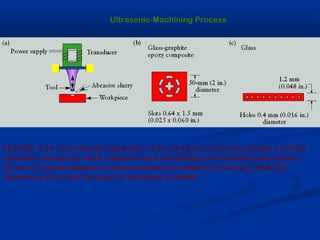
ultrasonic maching
- 1. Ultrasonic-Machining Process FIGURE 9.19 (a) Schematic illustration of the ultrasonic-machining process by which material is process by which material is removed through microchipping and erosion. (b) and (c) typical examples of holes produced by ultrasonic machining. Note the dimensions of cut and the types of workpiece materials.
- 3. Ultrasonic waves: Magnetostrictive transducers Magnetostrictive transducers use the inverse magnetostrictive effect to convert magnetic energy into ultrasonic energy. This is accomplished by applying a strong alternating magnetic field to certain metals, alloys and ferrites. Ultrasonic waves: Piezoelectric Transducers Piezoelectric transducers employ the inverse piezoelectric effect using natural or synthetic single crystals (such as quartz) or ceramics (such as barium titanate) which have strong piezoelectric behavior. Ceramics have the advantage over crystals in that they are easier to shape by casting, pressing and extruding.
- 4. Principle of Ultrasonic Machining In the process of Ultrasonic Machining, material is removed by micro-chipping or erosion with abrasive particles. In USM process, the tool, made of softer material than that of the workpiece, is oscillated by the Booster and Sonotrode at a frequency of about 20 kHz with an amplitude of about 25.4 um (0.001 in). The tool forces the abrasive grits, in the gap between the tool and the workpiece, to impact normally and successively on the work surface, thereby machining the work surface.
- 5. Principle of Ultrasonic Machining standard mechanism used in most of the universal Ultrasonic machines - 1
- 6. Principle of Ultrasonic Machining During one strike, the tool moves down from its most upper remote position with a starting speed at zero, then it speeds up to finally reach the maximum speed at the mean position. Then the tool slows down its speed and eventually reaches zero again at the lowest position. When the grit size is close to the mean position, the tool hits the grit with its full speed. The smaller the grit size, the lesser the momentum it receives from the tool. Therefore, there is an effective speed zone for the tool and, correspondingly there is an effective size range for the grits.
- 7. Principle of Ultrasonic Machining In the machining process, the tool, at some point, impacts on the largest grits, which are forced into the tool and workpiece. As the tool continues to move downwards, the force acting on these grits increases rapidly, therefore some of the grits may be fractured. As the tool moves further down, more grits with smaller sizes come in contact with the tool, the force acting on each grit becomes less. Eventually, the tool comes to the end of its strike, the number of grits under impact force from both the tool and the workpiece becomes maximum. Grits with size larger than the minimum gap will penetrate into the tool and work surface to different extents according to their diameters and the hardness of both surfaces.
- 8. Mechanism Piezoelectric Transducer Piezoelectric transducers utilize crystals like quartz whose dimensions alter when being subjected to electrostatic fields. The charge is directionally proportional to the applied voltage. To obtain high amplitude vibrations the length of the crystal must be matched to the frequency of the generator which produces resonant conditions.
- 9. Mechanism Magnetostictive transducer Magnetostictive transducers work on the principle that if a piece of Ferro- magnetic material (like nickel) is magnetized, then a change in dimension occurs. The transducer has solenoid type winding of wire over a stack of nickel laminations (which has rapid dimensional change when placed in magnetic fields) and is fed with an A.C supply with frequencies up to 25,000 c/s.
- 10. Mechanism Abrasive Slurry The abrasive slurry contains fine abrasive grains. The grains are usually boron carbide, aluminum oxide, or silicon carbide ranging in grain size from 100 for roughing to 1000 for finishing. It is used to microchip or erode the work piece surface and it is also used to carry debris away from the cutting area.
- 11. Mechanism Tool holder The shape of the tool holder is cylindrical or conical, or a modified cone which helps in magnifying the tool tip vibrations. In order to reduce the fatigue failures, it should be free from nicks, scratches and tool marks and polished smooth.
- 12. Mechanism Tool Tool material should be tough and ductile. Low carbon steels and stainless steels give good performance. Tools are usually 25 mm long ; its size is equal to the hole size minus twice the size of abrasives. Mass of tool should be minimum possible so that it does not absorb the ultrasonic energy.
- 13. Materials that can be machined on USM Hard materials like stainless steel, glass, ceramics, carbide, quatz and semi-conductors are machined by this process. It has been efficiently applied to machine glass, ceramics, precision minerals stones, tungsten. Brittle materials Applications It is mainly used for (1) drilling (2) grinding, (3) Profiling (4) coining (5) piercing of dies (6) welding operations on all materials which can be treated suitably by abrasives.
- 14. Advantages of USM Disadvantages of USM Machining any materials regardless of their conductivity USM has low material removal rate. USM apply to machining semi- conductor such as silicon, germanium Tool wears fast in USM. etc. Machining area and depth is USM is suitable to precise machining restraint in USM. brittle material. USM does not produce electric, thermal, chemical abnormal surface. Can drill circular or non-circular holes in very hard materials Less stress because of its non-thermal characteristics
